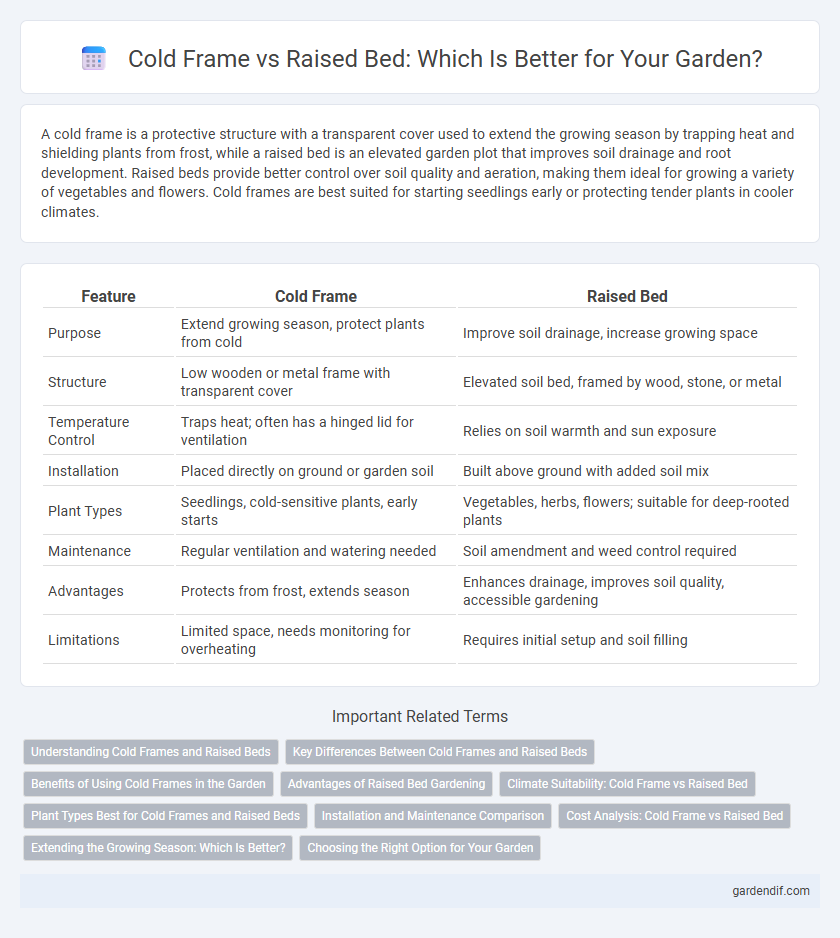
Cold frame vs Raised bed Illustration
A cold frame is a protective structure with a transparent cover used to extend the growing season by trapping heat and shielding plants from frost, while a raised bed is an elevated garden plot that improves soil drainage and root development. Raised beds provide better control over soil quality and aeration, making them ideal for growing a variety of vegetables and flowers. Cold frames are best suited for starting seedlings early or protecting tender plants in cooler climates.
Table of Comparison
| Feature | Cold Frame | Raised Bed |
|---|---|---|
| Purpose | Extend growing season, protect plants from cold | Improve soil drainage, increase growing space |
| Structure | Low wooden or metal frame with transparent cover | Elevated soil bed, framed by wood, stone, or metal |
| Temperature Control | Traps heat; often has a hinged lid for ventilation | Relies on soil warmth and sun exposure |
| Installation | Placed directly on ground or garden soil | Built above ground with added soil mix |
| Plant Types | Seedlings, cold-sensitive plants, early starts | Vegetables, herbs, flowers; suitable for deep-rooted plants |
| Maintenance | Regular ventilation and watering needed | Soil amendment and weed control required |
| Advantages | Protects from frost, extends season | Enhances drainage, improves soil quality, accessible gardening |
| Limitations | Limited space, needs monitoring for overheating | Requires initial setup and soil filling |
Understanding Cold Frames and Raised Beds
Cold frames are low, transparent-roofed enclosures designed to protect plants from cold temperatures and extend the growing season by trapping solar heat. Raised beds, constructed by elevating soil above ground level using frames made from wood, stone, or other materials, improve soil drainage, aeration, and root growth while enabling easier access for gardening. Understanding the distinct functions of cold frames for temperature regulation and raised beds for soil management helps optimize garden productivity and plant health.
Key Differences Between Cold Frames and Raised Beds
Cold frames provide a controlled microclimate for seedlings by using a transparent lid to trap heat, whereas raised beds offer improved soil drainage and root aeration by elevating the planting area above ground level. Cold frames are primarily designed for extending the growing season in cooler climates, while raised beds focus on enhancing soil quality and accessibility for gardeners. Temperature regulation and seasonal use distinguish cold frames from the year-round structural benefits of raised beds.
Benefits of Using Cold Frames in the Garden
Cold frames extend the growing season by providing a protected microclimate that retains heat and shields plants from frost, allowing gardeners to start seedlings earlier and harden off young plants effectively. They conserve water by reducing evaporation and can protect delicate plants from pests and harsh weather conditions without the need for electricity or complex systems. Compared to raised beds, cold frames offer enhanced temperature control and protection, making them ideal for nurturing tender crops and improving overall garden productivity.
Advantages of Raised Bed Gardening
Raised bed gardening offers superior soil control, allowing for optimized drainage and nutrient-rich conditions that promote healthy plant growth. The elevated structure reduces soil compaction and eases weed management, leading to higher yields with less effort. Enhanced accessibility and better pest control capabilities make raised beds a practical choice for both novice and experienced gardeners.
Climate Suitability: Cold Frame vs Raised Bed
Cold frames provide enhanced protection against frost and cold temperatures, making them ideal for extending the growing season in cooler climates. Raised beds offer superior soil drainage and temperature control but may require additional protection in harsh winters. Gardeners in temperate climates benefit from combining raised beds with cold frames to optimize plant growth and climate adaptability.
Plant Types Best for Cold Frames and Raised Beds
Cold frames are ideal for protecting tender seedlings, herbs, and leafy greens like spinach and lettuce during early spring or late fall, extending the growing season by providing a warm microclimate. Raised beds excel for a wide range of plants, including root vegetables like carrots and beets, tomatoes, peppers, and bushy crops, due to improved soil drainage and root aeration. Choosing between cold frames and raised beds depends on plant temperature sensitivity and growth requirements, with cold frames favoring cold-hardy and young plants, while raised beds support diverse, mature vegetables and flowers.
Installation and Maintenance Comparison
Cold frames require careful placement to maximize sunlight exposure and often involve installing a transparent lid or cover that can be opened or closed for temperature regulation. Raised beds demand constructing sturdy frames, typically from wood or metal, and filling them with quality soil that may need replenishing or conditioning over time. Maintenance for cold frames centers on managing ventilation and moisture levels, whereas raised beds focus on soil health, weed control, and structural integrity.
Cost Analysis: Cold Frame vs Raised Bed
Cold frames typically cost between $100 and $300 depending on size and materials, offering a budget-friendly option for season extension with minimal structural investment. Raised beds range from $150 to $500 or more, influenced by materials like cedar, composite, or metal, and their durability adds long-term value despite higher initial costs. While cold frames conserve heat and protect seedlings effectively at a lower upfront price, raised beds provide better soil control and drainage, which can reduce maintenance expenses over time.
Extending the Growing Season: Which Is Better?
Cold frames provide superior temperature control by trapping solar heat, making them ideal for extending the growing season in early spring and late fall. Raised beds, while improving soil drainage and root development, offer less insulation against frost and cold temperatures. For gardeners aiming to maximize growing season length, especially in cooler climates, cold frames are generally the better choice.
Choosing the Right Option for Your Garden
A raised bed provides superior soil drainage and root development, making it ideal for gardeners seeking controlled growing conditions and improved plant health. Cold frames offer effective protection against frost and extend the growing season by creating a microclimate but may limit root space compared to raised beds. Selecting between a raised bed and a cold frame depends on your garden's climate, crop requirements, and the need for temperature regulation versus soil structure enhancement.
Cold frame vs Raised bed Infographic

 gardendif.com
gardendif.com